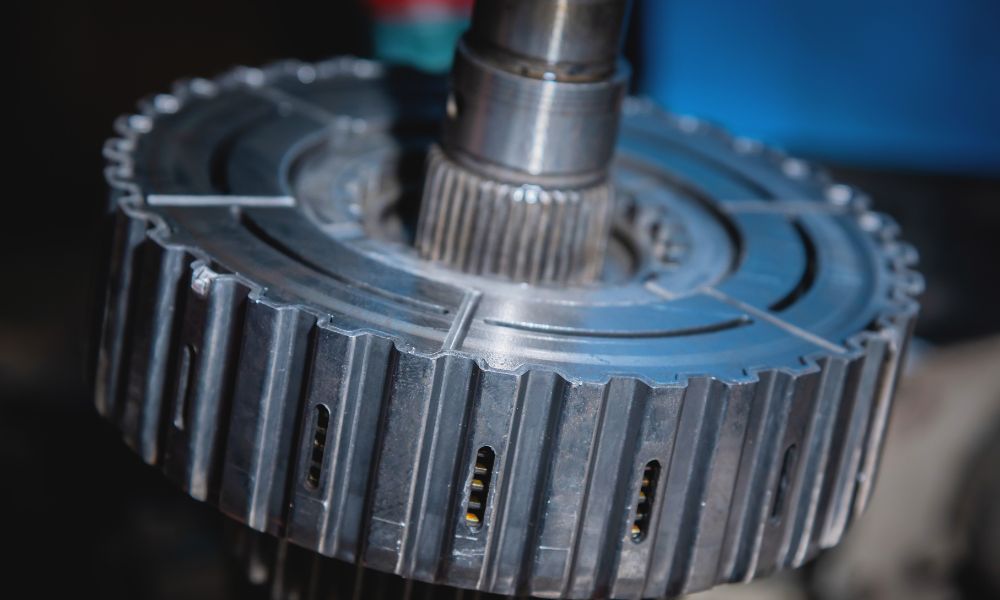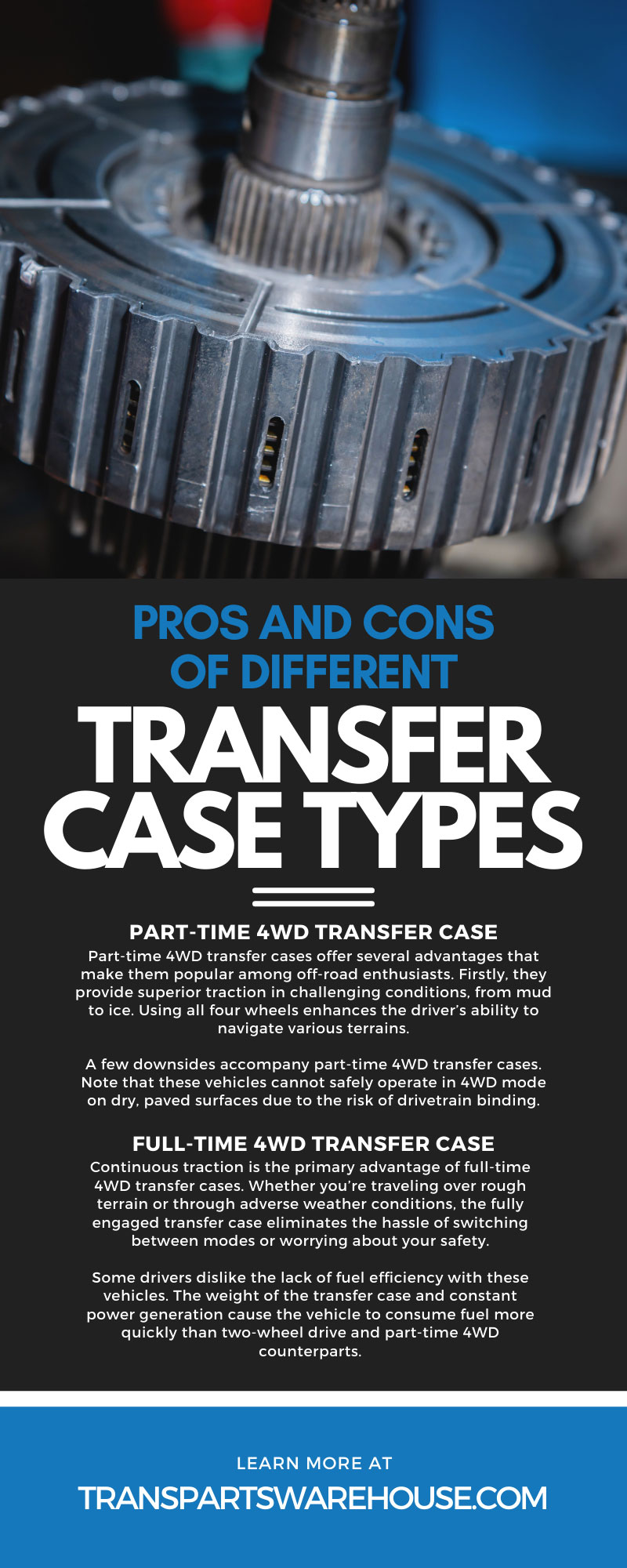
Transfer cases are the mastermind behind four-wheel drive (4WD) and all-wheel drive (AWD) vehicles. There are four primary types of transfer cases in vehicles. If you’re in the market for a new car, here are the pros and cons you must know about each of these systems.
Part-Time 4WD Transfer Case
The part-time 4WD transfer gives drivers the capability to switch between two-wheel drive (2WD) and four-wheel drive (4WD). The 4WD mode provides additional traction by engaging all four wheels, but it’s not designed for continual use in all conditions.
The transfer case engages upon shifting the vehicle into 4WD, sending power to both the front and rear axles. Some systems require the vehicle to be at a complete stop for a successful mode transition, while others allow for on-the-fly shifts.
Pros
Part-time 4WD transfer cases offer several advantages that make them popular among off-road enthusiasts. Firstly, they provide superior traction in challenging conditions, from mud to ice. Using all four wheels enhances the driver’s ability to navigate various terrains.
These components offer better fuel efficiency in 2WD mode. Since power goes to the rear axle, the vehicle expends less energy and consumes less fuel.
The part-time 4WD has a straightforward design, which makes it reliable. Paired with the power to manually disengage, four-wheel drive reduces wear and tear on the drivetrain.
Cons
A few downsides accompany part-time 4WD transfer cases. Note that these vehicles cannot safely operate in 4WD mode on dry, paved surfaces due to the risk of drivetrain binding.
Another risk of this transfer case is the need to switch between two-wheel and four-wheel drive manually. It requires a great understanding of the vehicle and terrain. Improper use could cause extensive mechanical damage.
Full-Time 4WD Transfer Case
Full-time 4WD transfer cases operate differently from their part-time counterparts because they’re constantly engaged. All four wheels always receive power and traction.
The more complex devices incorporate a differential within the transfer case to accommodate the difference in rotational speeds between the front and rear axles. Drivers love the vehicle’s additional stability and performance!
Pros
Continuous traction is the primary advantage of full-time 4WD transfer cases. Whether you’re traveling over rough terrain or through adverse weather conditions, the fully engaged transfer case eliminates the hassle of switching between modes or worrying about your safety. The differential within the transfer case reduces the risk of drivetrain binding, so it’s safe to operate on off-road terrains and paved surfaces.
The vehicle also has an improved capability to manage bumps and turns. Drivers will have a smooth, comfortable ride regardless of road conditions. Vehicles with these transfer cases are particularly advantageous for people who frequently drive in slippery conditions.
Cons
A common downside of this style of transfer case is the higher repair or replacement cost. The more complex design requires more skillful labor and quality parts.
Some drivers dislike the lack of fuel efficiency with these vehicles. The weight of the transfer case and constant power generation cause the vehicle to consume fuel more quickly than two-wheel drive and part-time 4WD counterparts.
Active 4WD Transfer Case
Active 4WD transfer cases, also known as automatic or adaptive 4WD, are relatively new four-wheel-drive technology. These systems automatically adjust the amount of power sent to each wheel based on current driving conditions.
Continuous monitoring and adaptation are made possible through a sophisticated network of strategically placed sensors. These sensors detect parameters like wheel speed, throttle position, and traction levels. Then, the system can adjust and optimize performance with the gathered information.
Pros
Active 4WD transfer cases have many benefits, including adaptability. These systems automatically adjust the distribution of power to the wheels based on the current driving conditions, providing optimal performance without the need for driver intervention. This technology can offer a less distracting driving experience for drivers traveling in unpredictable conditions.
Secondly, active 4WD systems often incorporate advanced features such as torque vectoring. This technology can distribute power between the front and rear axles and between the left and right wheels, enhancing vehicle handling and cornering performance. When enabled by the system’s electronic control unit (ECU) and network of sensors, these features contribute to a safer and more controlled driving experience.
Cons
The complexity of active 4WD transfer cases can be their downfall. Repairs and maintenance are challenging for mechanics and costly for vehicle owners. Any malfunction within the system could require the intervention of a specialized mechanic.
Fuel consumption is another concern for owners of vehicles with active 4WD transfer cases. Even though they operate primarily in 2WD mode under normal driving conditions, the constant monitoring and adjusting of power distribution to maintain performance can increase fuel consumption.
All-Wheel Drive Transfer Case
All-wheel drive transfer cases continuously distribute power to the front and rear axles through a central differential. Unlike full-time 4WD, AWD systems dynamically adjust the power distribution between wheels to suit the driving conditions.
AWD systems are ideal for both on-road and off-road use. They offer the advantage of full-time four-wheel traction without requiring manual engagement.
These systems feature a combination of gears, differentials, and sometimes multi-disc clutches for power distribution. Modern AWD systems also incorporate advanced electronics and sensors that monitor various vehicle parameters, including wheel speed, traction, and throttle position. The system can dynamically adjust power distribution for incredible performance.
Pros
AWD transfer cases have a few key advantages: adaptability and ease of use. These systems automatically adjust power distribution to the wheels, enhancing vehicle handling and safety in different driving conditions. Also, they eliminate the need for manual adjustments for a convenient driving experience.
Drivers often feel safer when operating an AWD vehicle. It ensures optimal performance and handling, as the transfer case continuously monitors wheel traction and power.
Cons
It’s important to mention AWD systems lack a low-range option and may not be able to match the off-road capabilities of 4WD transfer cases. Extreme conditions, including steep inclines or deep mud, could pose a challenge for drivers with these vehicles.
The limited ability to provide sufficient torque and traction on challenging terrains is a result of the absence of a low-range gear ratio. This could be a deal-breaker for drivers who frequently explore the great outdoors.
Understanding the pros and cons of different transfer case types will give you the information you need to pick out your next vehicle. When it comes time to replace various transfer case components, you’ll be prepared with this plethora of knowledge!



